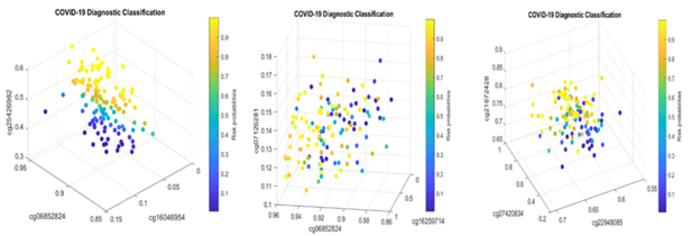Despite extensive efforts by researchers worldwide, the precise origins of COVID-19 remain shrouded in uncertainty. In a groundbreaking study recently released in the KeAi journal, Advances in Biomarker Sciences and Technology, an innovative AI-driven technique was employed to dissect DNA methylation patterns across a staggering 865,859 CpG sites found in blood samples taken from early COVID-19 patients. This study, spearheaded by Zhengjun Zhang from the Department of Statistics at the University of Wisconsin, harnesses advanced statistical analysis to illuminate possible connections to rare infectious diseases.
Utilizing a method known as max-logistic intelligence, Zhang and his team have unveiled significant genetic links that suggest COVID-19 may have originated from an unusual amalgamation of two rare diseases: glanders and Sennetsu fever. In tandem with common human diseases, the evidence presented in their findings challenges the prevailing narrative that attributes the virus’s origins primarily to wildlife, such as bats or pangolins. This revelation could redefine our understanding of how COVID-19 first emerged and spread among human populations.
The methods employed in this groundbreaking research push the boundaries of conventional virus origin analysis. Zhang articulates the complexity of establishing connections across such a vast array of CpG sites, stating that the likelihood of random correlations occurring is less than one in ten million. By accounting for the rarity of these diseases, the probability of revealing meaningful genetic associations further diminishes to an astounding one in one hundred million. Such strong odds substantiate the robustness of Zhang’s findings, suggesting a significant breakthrough in genetic epidemiology.
Max-logistic intelligence distinguishes itself from standard AI algorithms and contemporary machine learning methodologies like random forests, deep learning, and support vector machines by offering enhanced interpretability and consistency. These attributes make it particularly valuable for drawing causal relationships, which are often elusive in traditional research methodologies. As a result, researchers gain not just insights into statistical patterns but also a deeper understanding of the underlying biological mechanisms associated with disease development.
In recent years, the science community has witnessed an abundance of studies identifying potential markers related to COVID-19 and its associated health risks. However, Zhang highlights a troubling trend—many biomarkers identified in isolated cohorts have proven unreliable when tested across different populations. This presents a significant challenge in the quest for universally applicable health indicators. Such variability underscores the importance of establishing comprehensive methodologies that take into account diverse genetic backgrounds and environmental factors.
The role of DNA methylation in gene expression and the progression of diseases has garnered substantial attention, particularly since errors in methylation processes can catalyze various health disorders. According to Zhang, the emphasis placed on understanding COVID-19’s DNA methylation patterns is critical. By analyzing how methylation can be disrupted, researchers can glean insights not just into COVID-19, but also into potential therapeutic targets that might mitigate its impact.
Zhang’s compelling narrative woven through complex genetic landscapes reveals both the potential and limitations of current research paradigms. Appeals towards a broader understanding of viral origins are increasingly resonant, as researchers aim to piece together an intricate puzzle that could alter public health approaches moving forward. Acknowledging the prevailing narrative shaped by wildlife theories, Zhang’s findings posit a need for a reassessment of our focus and methodologies in uncovering virus origins.
As he draws attention to the operational mechanics behind DNA methylation, Zhang emphasizes the role of environmental triggers in disease manifestation. The interplay of genetic predisposition and external factors necessitates a nuanced approach to public health. This insight resonates through the scientific community as they engage in deeper discourse on the significance of genetics in the context of emerging infectious diseases.
To ensure progress, Zhang insists on the imperative to rethink research frameworks and methodologies. The prevailing experiments must evolve to foster collaborative efforts, merging insights from various fields, including molecular biology, biochemistry, and computational biology. By transcending traditional boundaries, scientists can generate a richer context from which to derive actionable insights.
The study’s implications extend beyond academic contributions; they compel policymakers and public health officials to reassess prevailing assumptions regarding disease origins and transmission. The epidemiological landscape of COVID-19 requires flexibility and adaptation, with insights from genetic studies aiding in the development of more targeted interventions and strategies.
As researchers digest this information, the scientific community holds its breath, waiting for follow-up studies and further validations. The transformation of perceptions regarding COVID-19’s origins could pave new pathways in managing similar diseases in the future. The results from Zhang’s investigation beckon an era of renewed inquiry and constant evaluation of established theories. It compels the community not just to ask “how” but “why”—a fundamental inquiry necessary in navigating the uncharted waters of global health threats.
In a world irrevocably altered by the pandemic, this research signals a shift in perspective regarding how viruses can emerge and evolve. Zhang’s assertions may lead to comprehensive re-evaluations of wildlife-centric models and open avenues for exploring new territories of research. It serves as a reminder of the endless complexities of human health and disease, urging scientists and laypeople alike to remain diligent in their pursuit of understanding.
Through the lens of Zhang’s insights, we are confronted with the power of scientific inquiry to illuminate even the murkiest of realities, inspiring hope for future discoveries that can protect and improve global health.
Subject of Research: Not applicable
Article Title: Etiological connections between initial COVID-19 and two rare infectious diseases
News Publication Date: Not applicable
Web References: Not applicable
References: Not applicable
Image Credits: Zhang, Z.
Keywords: Life sciences, Microbiology, Bioinformatics, Molecular biology, Toxicology, Virology
Tags: AI in virus origin studiesCOVID-19 origins researchDNA methylation patterns analysisearly COVID-19 patient studiesgenetic links to COVID-19glanders and Sennetsu feverinterdisciplinary approaches in infectious disease researchmax-logistic intelligence methodrare infectious diseases connectionsrethinking zoonotic disease transmissionstatistical analysis in epidemiologyunconventional virus origin theories





